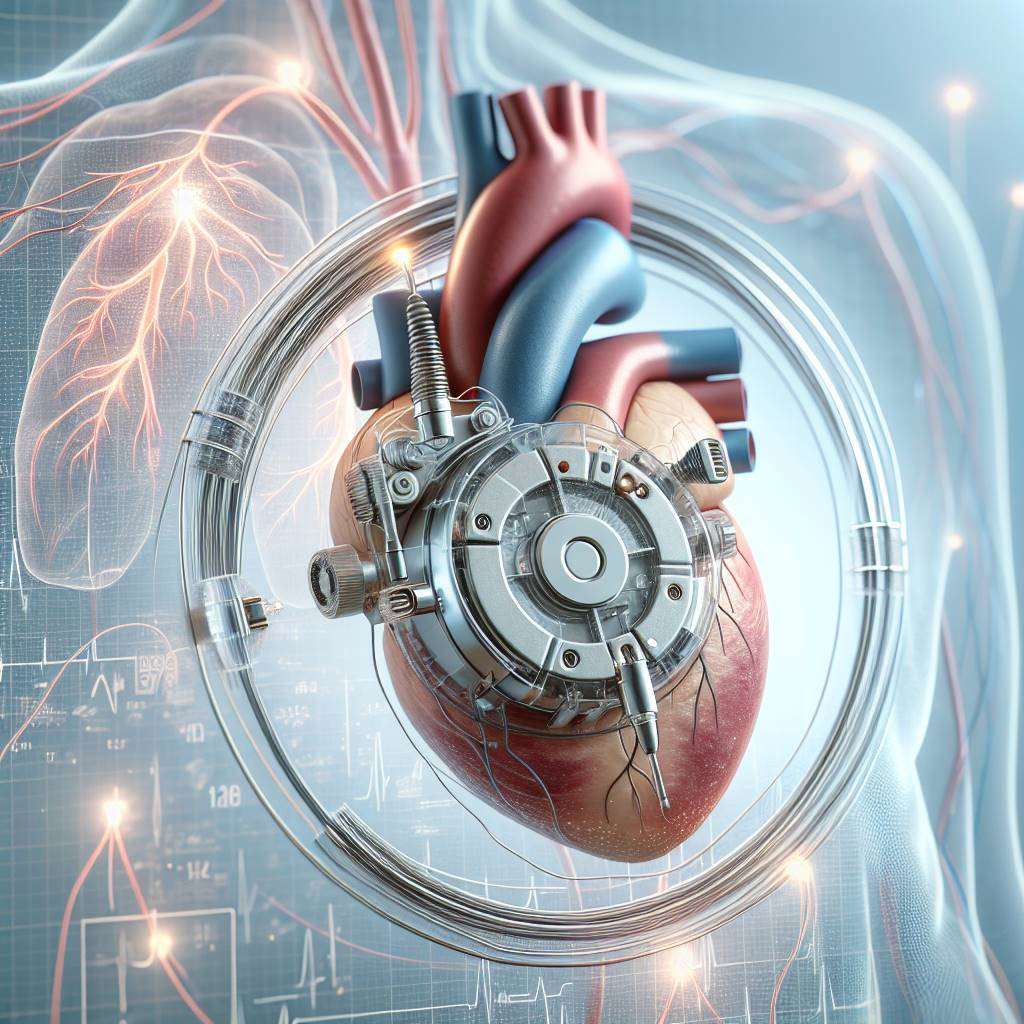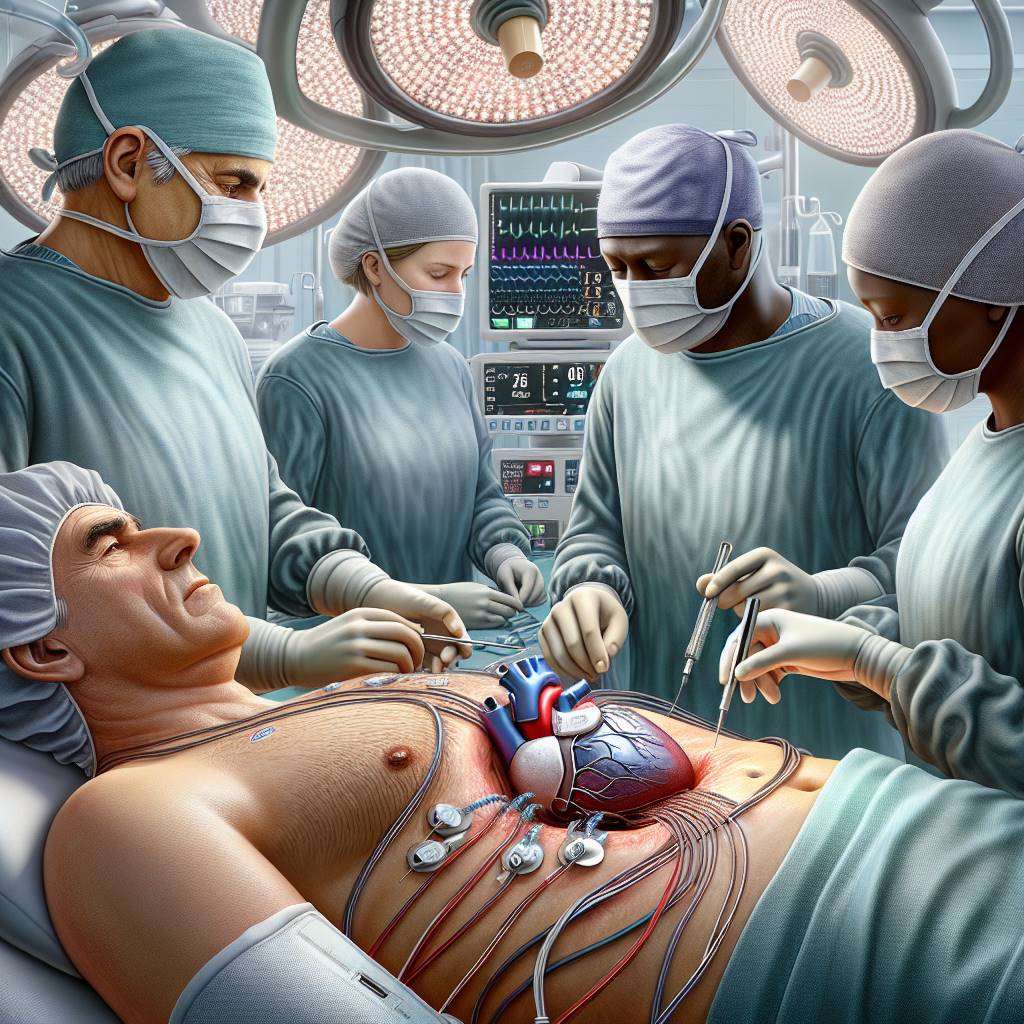A pacemaker is a small medical device implanted in the chest to help regulate abnormal heart rhythms, also known as arrhythmias. It ensures that the heart beats at a normal and steady rate, which is crucial for maintaining proper blood flow and overall health. Pacemakers are life-saving devices for patients with slow or irregular heartbeats.
Understanding how a pacemaker works can help patients feel more confident about their treatment. These devices are commonly used to treat conditions like bradycardia (slow heart rate) or heart block. By sending electrical signals to the heart, pacemakers restore normal rhythm and improve quality of life for millions of patients worldwide.
What Is a Pacemaker and Why Is It Needed?
A pacemaker is a small, battery-operated device that helps control the heartbeat. It is implanted under the skin, usually near the collarbone, and connected to the heart through thin wires called leads. The device monitors the heart's electrical activity and sends electrical impulses when it detects an abnormal rhythm.
Pacemakers are often recommended for patients with arrhythmias, such as bradycardia, where the heart beats too slowly, or heart block, where electrical signals are delayed or blocked. Without proper treatment, these conditions can lead to fatigue, dizziness, or even life-threatening complications like heart failure.
By maintaining a steady heart rate, pacemakers improve blood circulation, reduce symptoms, and enhance overall quality of life. They are a vital solution for patients with chronic heart rhythm disorders.

Understanding the Role of a Pacemaker in Heart Health
The heart relies on electrical signals to pump blood effectively. When these signals are disrupted, it can lead to irregular heartbeats or arrhythmias. A pacemaker acts as an artificial regulator, ensuring that the heart maintains a consistent rhythm.
Pacemakers are particularly important for patients with conditions like bradycardia, where the heart beats too slowly, or atrial fibrillation, which causes irregular rhythms. By sending electrical impulses to the heart, the device helps restore normal function and prevents complications such as fainting, fatigue, or organ damage due to poor blood flow.
In addition to improving heart health, pacemakers also allow patients to lead more active and fulfilling lives. Regular follow-ups with a cardiologist ensure that the device is functioning optimally and meeting the patient’s needs.
How Does a Pacemaker Help Regulate Heartbeats?
A pacemaker works by monitoring the heart's natural electrical activity. If it detects a slow or irregular rhythm, it sends a small electrical impulse to stimulate the heart muscle and restore a normal beat. This process happens automatically and is not felt by the patient.
The device consists of two main parts: a pulse generator, which produces the electrical signals, and leads, which deliver these signals to the heart. Modern pacemakers are highly advanced and can adjust their function based on the patient’s activity level, ensuring the heart works efficiently during rest and exercise.
By regulating the heartbeat, pacemakers prevent symptoms like dizziness, shortness of breath, and fatigue. They are a reliable and effective treatment for managing arrhythmias and improving overall heart health.
Types of Pacemakers: Which One Is Right for You?
There are several types of pacemakers, each designed to address specific heart conditions. The most common types include:
- Single-chamber pacemaker: Sends electrical signals to one chamber of the heart, usually the right atrium or right ventricle.
- Dual-chamber pacemaker: Regulates both the right atrium and right ventricle, ensuring better coordination between the chambers.
- Biventricular pacemaker: Used for patients with heart failure, it stimulates both ventricles to improve the heart's pumping efficiency.
Your cardiologist will recommend the most suitable type based on your specific condition, such as bradycardia or heart block. Factors like age, lifestyle, and overall health also play a role in determining the right pacemaker for you.
Step-by-Step Guide to How a Pacemaker Works
Understanding how a pacemaker functions can help ease concerns about the device. Here’s a step-by-step guide:
- The pacemaker continuously monitors the heart's electrical activity.
- If it detects a slow or irregular rhythm, it sends a small electrical impulse to the heart muscle.
- This impulse stimulates the heart to beat at a normal rate, ensuring proper blood flow.
- Modern pacemakers can adjust their activity based on the patient’s physical activity or rest.
Regular check-ups ensure the device is functioning correctly and the battery is in good condition. With proper care, pacemakers can last for many years and significantly improve the quality of life for patients with arrhythmias.
What Happens During a Pacemaker Implantation Procedure?
A pacemaker implantation is a relatively simple and safe procedure performed to manage irregular heart rhythms, also known as arrhythmias. The procedure is typically done under local anesthesia, ensuring the patient remains awake but pain-free. A small incision is made near the collarbone, and the pacemaker device is inserted under the skin.
Thin wires, called leads, are guided through a vein into the heart. These leads connect the pacemaker to the heart, allowing it to monitor and regulate the heartbeat. The entire process usually takes about 1–2 hours, and most patients can return home the same day or the next.
After the procedure, patients may experience mild discomfort at the incision site, but this typically resolves within a few days. It’s important to follow your doctor’s advice for recovery and avoid strenuous activities during the healing period.

How Pacemakers Detect and Correct Irregular Heart Rhythms
A pacemaker is a small, battery-operated device that helps regulate the heart's rhythm. It continuously monitors the heart's electrical activity through its leads. If the pacemaker detects a slow heartbeat (bradycardia) or other irregularities, it sends electrical impulses to stimulate the heart and restore a normal rhythm.
Modern pacemakers are highly advanced and can adapt to the body’s needs. For example, they can increase the heart rate during physical activity and slow it down during rest. This ensures the heart functions efficiently under different conditions.
- Monitors the heart’s electrical signals.
- Delivers electrical impulses when needed.
- Adapts to the body’s activity levels.
By correcting arrhythmias, pacemakers help prevent symptoms like fatigue, dizziness, and fainting, improving the patient’s overall quality of life.
Battery Life and Maintenance of a Pacemaker Explained
The battery life of a pacemaker is an important consideration for patients. Most pacemakers are powered by lithium batteries, which can last between 5 to 15 years, depending on the device type and usage. Regular check-ups with your doctor are essential to monitor the battery status.
When the battery runs low, the pacemaker will not stop working suddenly. Instead, it provides ample warning, allowing time for a replacement procedure. This replacement is a minor surgery where only the device is replaced, while the leads often remain intact.
To maintain your pacemaker, avoid prolonged exposure to strong electromagnetic fields, such as those from MRI machines or certain industrial equipment. Always inform healthcare providers about your pacemaker before undergoing any medical procedures.
Can You Feel a Pacemaker Working Inside You?
Many patients wonder if they can feel their pacemaker working. In most cases, the answer is no. Pacemakers are designed to operate silently and seamlessly, without causing discomfort. However, some people may feel a slight flutter or sensation in their chest when the device sends electrical impulses to the heart.
It’s important to note that these sensations are usually mild and temporary. If you experience persistent discomfort or unusual symptoms, such as chest pain or dizziness, consult your doctor immediately. These could indicate a problem with the device or its settings.
Overall, pacemakers are highly effective at managing heart rhythm disorders, and most patients quickly adapt to living with the device.
Common Myths About Pacemakers Debunked
There are several misconceptions about pacemakers that can cause unnecessary worry for patients. Let’s address some of the most common myths:
- Myth: Pacemakers are only for elderly people. Fact: Pacemakers can benefit people of all ages with arrhythmias.
- Myth: You can’t use electronic devices with a pacemaker. Fact: Most household electronics are safe, but avoid close contact with strong magnets.
- Myth: Pacemaker surgery is risky. Fact: It’s a routine and low-risk procedure.
By understanding the facts, patients can feel more confident about their treatment and focus on the benefits of improved heart health.
What to Expect After Getting a Pacemaker Implanted
A pacemaker is a small device implanted under the skin to help regulate your heart's rhythm. After the procedure, you may experience mild discomfort or swelling at the implant site. This is normal and usually subsides within a few days.
It’s important to follow your doctor’s advice regarding physical activity. Avoid heavy lifting or strenuous activities for the first few weeks to allow proper healing. Regular follow-ups will ensure your pacemaker is functioning correctly and your heart rhythm remains stable.
Common post-implantation instructions include keeping the incision site clean and dry, monitoring for signs of infection, and avoiding certain electronic devices that may interfere with the pacemaker. Always consult your doctor if you notice unusual symptoms like dizziness or chest pain.

Are Pacemakers Safe? Risks and Benefits to Know
Pacemakers are generally safe and have been used for decades to treat heart rhythm disorders like bradycardia (slow heart rate). The benefits often outweigh the risks, as they help maintain a steady heartbeat and improve overall quality of life.
However, like any medical procedure, there are potential risks. These include infection at the implant site, allergic reactions to the device materials, or rare complications like device malfunction. Your doctor will discuss these risks with you before the procedure.
The benefits of a pacemaker include reduced symptoms of fatigue, dizziness, and fainting caused by irregular heartbeats. It also lowers the risk of more serious complications like heart failure. Regular check-ups ensure the device continues to work effectively.
Living with a Pacemaker: Tips for Everyday Life
Living with a pacemaker requires some lifestyle adjustments, but most people can return to their normal activities. It’s essential to avoid close contact with strong magnetic fields, such as those from MRI machines or industrial equipment, as they can interfere with the device.
Here are some tips for managing daily life with a pacemaker:
- Carry a pacemaker ID card to inform healthcare providers about your device.
- Avoid placing mobile phones or headphones directly over the pacemaker site.
- Follow your doctor’s advice on physical activity and avoid contact sports.
With proper care and regular follow-ups, a pacemaker can help you lead a healthy and active life. Always consult your doctor if you experience unusual symptoms or have concerns about your device.
How Modern Pacemakers Are Improving Heart Care
Modern pacemakers are equipped with advanced technology that makes them more effective and reliable. Many devices now come with wireless monitoring, allowing doctors to track your heart’s activity remotely and adjust settings as needed.
Some pacemakers are designed to adapt to your activity level, increasing or decreasing your heart rate based on your physical exertion. This feature, known as rate responsiveness, ensures your heart functions optimally during exercise or rest.
Additionally, newer pacemakers are smaller and have longer battery life, reducing the need for frequent replacements. These advancements have made pacemakers a cornerstone of cardiac care, improving outcomes for patients with heart rhythm disorders.
When Should You Consider Getting a Pacemaker?
A pacemaker may be recommended if you have a heart condition that causes an irregular or slow heartbeat. Common conditions include bradycardia, heart block, or certain types of arrhythmias. Symptoms like fatigue, dizziness, or fainting may indicate the need for a pacemaker.
Your doctor will perform tests such as an ECG or Holter monitoring to evaluate your heart’s rhythm. If these tests show significant abnormalities, a pacemaker may be the best option to restore normal heart function.
It’s important to discuss your symptoms and medical history with your doctor. Early intervention can prevent complications and improve your quality of life. If you’re unsure, seek a second opinion to make an informed decision.
Best Pacemaker Surgery Doctors in India
Dr. Balbir Singh, affiliated with Max Super Speciality Hospital, Delhi, is a renowned cardiologist with over 30 years of experience. He specializes in electrophysiology and pacemaker implantation. Another expert is Dr. Naresh Trehan, Chairman of Medanta - The Medicity, Gurugram, with over 40 years of experience in cardiac surgery and international recognition for his contributions.
Learn more on best pacemaker implantation surgery doctors in india
Best Pacemaker Surgery Hospitals in India
Fortis Escorts Heart Institute, Delhi, and Apollo Hospitals, Chennai, are leading centers for pacemaker implantation. Both are NABH and JCI accredited, offering advanced cardiac care, including robotic-assisted procedures. These hospitals are known for their multidisciplinary teams, high success rates, and dedicated international patient services.
Find more best pacemaker implantation surgery hospitals in india
Pacemaker Surgery Cost in India
The cost of pacemaker implantation in India typically ranges between INR 2,50,000 to INR 5,00,000 (approximately USD 3,000 to USD 6,000). Factors like the type of pacemaker, hospital category, and doctor’s expertise influence the cost. The average hospital stay is 2-3 days. India offers a significant cost advantage compared to Western countries, with options for medical insurance and third-party financing.
Learn pacemaker implantation surgery cost in india
Pacemaker Surgery Treatment in India
Pacemaker implantation in India involves placing a small device under the skin to regulate heart rhythms. The procedure is performed under local anesthesia and guided by fluoroscopy. Advanced technologies like leadless pacemakers and robotic-assisted techniques are available. Recovery typically takes 1-2 weeks. Indian hospitals follow global medical protocols and adopt the latest innovations for patient safety.
Learn on Pacemaker Surgery Treatment in India
FAQs
What is a pacemaker?
A pacemaker is a small medical device implanted under the skin to regulate abnormal heart rhythms by sending electrical impulses to the heart.
Who needs a pacemaker?
Patients with bradycardia (slow heart rate), heart block, or other rhythm disorders may require a pacemaker to maintain a normal heart rate.
How long does a pacemaker last?
A pacemaker typically lasts 5-15 years, depending on the type and usage. Regular follow-ups are necessary to monitor its performance.
Is pacemaker implantation a major surgery?
No, pacemaker implantation is a minimally invasive procedure performed under local anesthesia, usually requiring a short hospital stay.
Are there any risks associated with pacemaker implantation?
Risks are minimal but may include infection, bleeding, or lead displacement. These are rare and manageable with proper care.
Can I lead a normal life with a pacemaker?
Yes, most patients can resume normal activities after recovery. However, certain precautions, like avoiding strong magnetic fields, are necessary.
How often should I have my pacemaker checked?
Pacemakers should be checked every 6-12 months to ensure they are functioning correctly and to monitor battery life.
Can I travel with a pacemaker?
Yes, you can travel with a pacemaker. Inform airport security about your device, as it may set off metal detectors.
What happens if the pacemaker battery runs out?
The battery does not stop suddenly. It provides warnings during follow-ups, allowing timely replacement through a minor procedure.
Are there different types of pacemakers?
Yes, pacemakers can be single-chamber, dual-chamber, or biventricular, depending on the condition being treated.
Understanding Pacemaker Technology: Monitoring and Travel Tips
Pacemakers have revolutionized cardiac care, allowing patients to lead active lives with enhanced heart function. One of the most significant advancements in this field is remote pacemaker monitoring, which enables healthcare providers to track a patient’s heart activity in real-time. This technology not only ensures timely interventions but also provides peace of mind for patients and their families.
For those with pacemakers, traveling can raise concerns, especially when navigating airport security. It’s essential to be informed about safety tips for airports and security checks. Knowing how to communicate with security personnel and understanding the implications of metal detectors can make your journey smoother and stress-free.
By staying informed about both remote monitoring and travel safety, pacemaker patients can enjoy their lives with confidence and security.